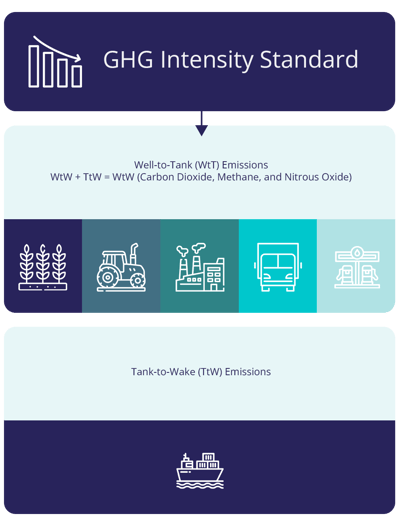The International Maritime Organisation’s (IMO) proposed Net Zero Framework (NZF) is set to become one of the most significant regulatory developments in shipping. While it is still in draft form and awaiting adoption in October 2025, the framework aims to simplify and standardise the industry’s pathway to achieving net zero greenhouse gas (GHG) emissions by around 2050.
Glossary
Before we start, here are some of the key abbreviations used throughout this article:
|
Abbreviation |
Meaning |
|---|---|
|
GHG |
Greenhouse Gas |
|
IMO |
International Maritime Organisation |
|
NZF |
Net Zero Framework |
|
MEPC |
Marine Environment Protection Committee |
|
ZNZ |
Zero or Near Zero |
|
TtW |
Tank to Wake |
|
WtW |
Well to Wake |
Why It Matters
Shipping moves over 80% of global trade by volume and, despite being the most carbon-efficient mode of cargo transport, still accounts for roughly 3% of global GHG emissions. With shipping demand projected to grow by 50% by 2050, the pressure to reduce emissions is mounting - not just from regulators, but also from cargo owners, charterers, and financiers linking emissions performance to lending.
Key Context from MEPC 83
The Paris Agreement’s temperature goals underpin this work, with the IMO recognising carbon dioxide CO₂, methane (CH₄), and nitrous oxide (N₂O) as major climate-warming gases, alongside pollutants like NOx, SOx, particulate matter, and black carbon.
The Net Zero Framework is designed to:
- Apply to ships over 5,000 GT, with exemptions for domestic-only vessels, those without mechanical propulsion, and specific offshore units.
- Enter into force from 1 March 2027, with full data reporting beginning in 2028 and verification from 2029.
- Require the use of Zero or Near Zero (ZNZ) GHG emission technologies—primarily fuels and energy sources.

Tentative timeline of implementation
From Tank-to-Wake to Well-to-Wake
A major shift is that regulations will now cover the entire fuel value chain, known as Well-to-Wake (WtW) emissions. This includes fuel production, refining, distribution, and onboard combustion - offering a more accurate picture of a fuel’s true climate impact. All fuels will need a certified Fuel Lifecycle Label (FLL) with a Greenhouse Gas Fuel Intensity (GFI) score.
Compliance Process
The regulations introduce two tiers of compliance, Base and Direct, requiring progressively tougher GFI targets from 2028 to 2050. Ships may use lower-GFI fuels to meet targets or pay penalties for shortfalls, with revenues reinvested into clean-fuel development, infrastructure, and training.
Industry Outlook
While many see the NZF as a vital global step, some argue it is too lenient compared to earlier climate goals. Others feel it is overly ambitious and complex, pointing to uncertainty over enforcement, alignment with regional schemes like FuelEU Maritime, and the availability of sustainable fuels.
How the IMO’s Net Zero Framework Measures Fuel Emissions
One of the biggest changes in the IMO’s Net Zero Framework is the move from regulating only onboard emissions (Tank-to-Wake) to a full Well-to-Wake (WtW) approach.
What Does Well-to-Wake Mean?
Well-to-Wake covers all greenhouse gas emissions generated during a fuel’s lifecycle:
- Feedstock Management – assessing availability, harvesting potential, competition for resources, transport to production sites, and environmental impacts of land-use change.
- Production and Distribution – accounting for all energy and material inputs, emissions from feedstock handling and storage, and the transport of both raw materials and final fuel to consumers.
- End Use – emissions from fuel combustion onboard, including CO₂, methane, and nitrous oxide.
The calculation, known as a Life Cycle Assessment (LCA), is certified by Sustainable Fuels Certification Schemes (SFCS) recognised by the IMO. Fossil fuels will be assigned conservative default values, while sustainable fuels will be assessed on specific production pathways.
Introducing the Greenhouse Gas Fuel Intensity (GFI)
The GFI measures annual GHG emissions (in gCO₂eq) per unit of energy on a ship, on a Well-to-Wake basis.
- Lower GFI = lower lifecycle emissions.
- From 2028–2035, targets are set to reduce GFI by 20–30% (Base vs Direct compliance), with reviews every 5 years.
Compliance Flexibility
Ships meeting stricter targets can generate surplus units for transfer, banking, or voluntary surrender. Deficits require the purchase of remedial units, with penalties ranging from $100–$380 per tonne CO₂eq depending on the compliance tier. Revenues will fund ZNZ fuel adoption, infrastructure, training, and support for vulnerable states.
Why It’s Complicated
Establishing uniform LCA standards is challenging due to the almost infinite variables in fuel production, transport, and use. Alignment with other regulatory schemes, such as FuelEU Maritime, also remains unclear.
Coming Up
In part two of this series, we will explore how the industry can prepare their vessels and fleets for the requirements of the Net Zero Framework. We will also introduce alternative fuels, examining their applications and the potential role they can play in helping the industry achieve net zero emissions.
Why not join our webinar?
Looking for more detail? Join Idwal on the 4th September at 13:00 BST for an in depth discussion on the commercial ramifications of MEPC 83 and the IMO Net Zero Framework alongside exactly how you and your business can get ahead of the curve.


Submit a comment